How to close the pipes in the toilet: 3 budget options
Toilet - one of the most frequently visited places in an apartment or private house. As a rule, due to its specificity, a lot of different pipes and devices are concentrated in it: hot and cold water supply, sewage, stop valves, metering devices, and so on. The instruction given in this material tells how to clean the pipes in the toilet without spending a lot of money on it.
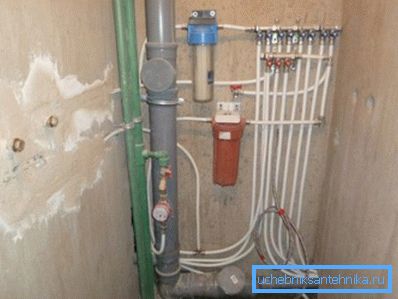
Preparatory stage
When choosing a way to disguise engineering networks, it is necessary to remember that all water transport communications require periodic maintenance. Therefore, you should worry in advance about how to clean the sewer pipe in the toilet or to fix the leakage of water.
If you do not provide a door to the toilet for pipes, you may have to completely break down the previously designed and tiled box. But the price of restoration work can be quite high.
Preventive measures will help to avoid problems in the future, which are recommended to be carried out before you sew up the pipes with a drywall box or disguise them with the help of a wall cabinet.
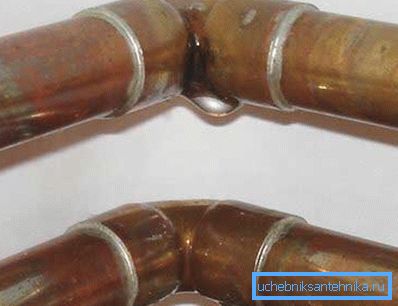
It is advisable to pay attention to such problems:
- Set whether the pipe is leaking in the toilet or not. To do this, you need to inspect all connections for tightness. It is desirable that the fittings are made of the same material as the water supply (especially hot water). In this case, the coefficient of thermal expansion of each part will be the same, thus avoiding deformation.
- Some ask why water and sewage pipes sweat.. It should be noted here that this is a completely natural phenomenon. In order to avoid corrosion of metal pipes from condensable moisture, it is advisable to protect the pipe with polystyrene foam shells or polyethylene foam.
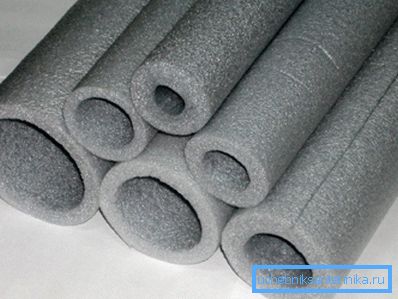
Tip! Before you sheathe the pipes in the toilet, it is advisable to make a complete modernization of water distribution networks in the apartment. So you are 100% protect yourself from accidents after the end of the decorative finishing plumbing facilities.
Design options for self-production
The lining or decoration of pipes in the toilet can be made using various materials. It all depends on your imagination, skills in metalworking tools and the planned budget.
The main requirement for a decorative design is the possibility of its prompt dismantling if necessary. The fact is that the door in the toilet for pipes is not always suitable for the elimination of serious accidents. And with a rush of plumbing or blockage of sewage time is sometimes the decisive factor separating a small puddle from the flood, which floods the neighbors from below.
Consider the most common designs that can easily be made by hand.
Option 1. Plasterboard or plastic box
This option, despite the apparent complexity, is available for the manufacture of even not very experienced craftsmen. Most often used for the box frame made of galvanized profile, at least - from wooden bars.
Plastic sheeting does not require additional decorative finishing at all, and drywall is most often subsequently pasted over with ceramic tiles, which are matched to the walls and floor.
Consider the option when the plumbing in the toilet is plastic.
For work you will need:
- metal profile or wooden bars;
- plastic panels;
- dowels or anchor bolts;
- self-tapping screws.

The process of work for convenience of presentation will be divided into several successive stages:
- The first stage is the markup. It is necessary to note the dimensions of the future box for pipes on the floor and ceiling, and then using a laser level or plumb line - apply the markings on the walls as well.
Note! Plumbing and sewage should not come into contact with the cladding material. It is necessary that the fixed plastic sheet should be at least 3-4 cm from the pipes. Consider this when choosing sizes.
- Then, using dowels, the galvanized profile is attached to the walls. After that, the end support elements are installed. Between them, you can mount additional parts that provide structural rigidity. If the width of the box exceeds 25 cm, and the length of 1.5 m - the presence of stiffeners is mandatory. Otherwise, the frame may collapse during the plating process.
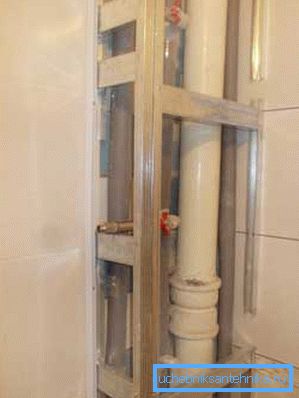
- After completing work with the frame, you can proceed to the installation of plastic sheets. They begin to fasten from the side faces, then move to the front. As fasteners used screws with decorative heads. A similar scheme is made and the design of the plasterboard box. When marking, do not forget to take into account the thickness of the material used. Pay particular attention to the size of the door used to inspect water pipes. It is better if it is large, as this will facilitate all pipe manipulations in the future.

Option 2. Locker
The advantages of this method are that the decorative doors of the cabinet will elegantly hide all communications, and in case of need you will always have free access to any part of the engineering network.
Consider in detail the whole process:
- The frame is made of wooden bars, which is fixed on the walls of the toilet with dowels. To protect the wood from decay, it is desirable to treat the details with an antiseptic composition, and cuts of the bars - with building mastic.
- Piano or door hinges are attached to the frame, on which doors are hung. They can be made of laminated chipboard or MDF, as well as plywood. In the latter case, the structure must be varnished. It will make the cabinet more beautiful and protect it from moisture.
- Inside you can fix the shelves. Then, in addition to the aesthetic, your cabinet will carry a functional load - to serve as a storage place for household chemicals and similar items.
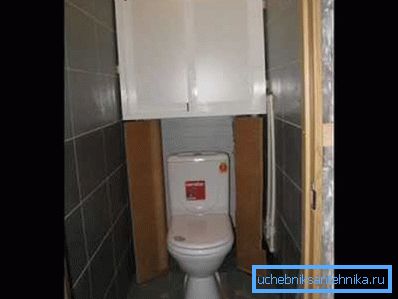
Downstairs (behind the toilet) pipes are closed with a screen. It can be fixed permanently or be removable.
When arranging it, consider the following points:
- the screen should fit snugly to the walls of the toilet room;
- it is necessary to make holes in it through which the drain and water pipes connected to the toilet bowl will pass;
- the screen should be easy to install and dismantle.
Option 3. Using blinds
Dressing pipes in the toilet using plastic Rolet can be considered the most appropriate option. Especially if the area of this room in your apartment is limited.
After all, any plastic or plasterboard box, as well as cabinets of various designs, will take up some space, making the toilet even closer.
Plastic rolt allows you to:
- completely hide engineering communications from the ceiling to the floor;
- ensure unhindered access to any part of the pipeline, valves and meters;
- opens and closes in seconds, which is important in case of pipeline accidents;
- has a modern appearance and fits perfectly into the design of the bathroom.

Conclusion
The above methods, which describe how to disguise the pipes in the toilet, are not the only possible ones. Showing a little imagination, you can come up with and implement your version. For more information about the design of sanitary facilities, you can learn from the video in this article.